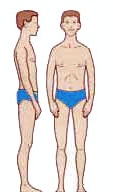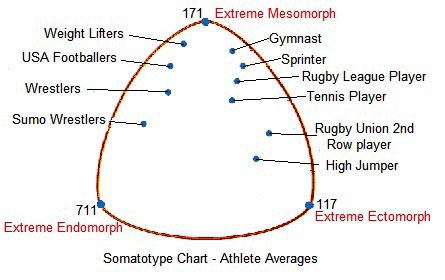

Body Types & Build
Success as an athlete comes from athletic ability, and our body build. The three components of body build are the type, size and composition. A system developed by W.H. Sheldon (c.1940)[2] uses Ectomorph, Endomorph, or Mesomorph to describe the individual's body build.
Body Type
Beashel and Taylor (1997)[4] identify three extremes of body types.
Endomorph
 |
Endomorph (711)
|
An endomorphic individual typically has short arms and legs and a large mass on their frame. Their mass hampers their ability to compete in sports requiring high agility or speed levels and perform sustained weight-bearing aerobic activities such as running. Sports of pure strength, like powerlifting, are perfect for an endomorph. They can gain weight easily and lose condition quickly if training stops.
Sports Benefits
- Size benefits sports such as rugby where bulk is useful, provided it can be moved powerfully
- Tend to have a large lung capacity, which can make them suited to sports such as rowing
- They can increase muscle mass much more quickly than ectomorphs
Mesomorph
 |
Mesomorph (171)
|
A mesomorphic individual excels in strength, agility, and speed. Their medium structure and height and their tendency to gain muscle and strength make them a strong candidates for a top athlete in any sport. They can sustain low body fat levels and find it easy to lose and gain weight.
Sports Benefits
- Respond well to cardiovascular and resistance training
- Can sustain low body fat levels
- All muscle groups can be used to derive positive training adoption
- Dependent on the sports' needs, they can quickly gain or lose weight
Ectomorph
 |
Ectomorph (117)
|
A predominantly ectomorphic individual is long, slender and thin, and therefore power and strength sports are perhaps not suitable as their slight build leaves them susceptible to injuries. While they can quickly get lean and hard, their lack of musculature severely limits their chances in sports requiring mass. Ectomorphs dominate endurance sports and gymnastics. They can archive low levels of body fat, which can be detrimental to health and for females, in endurance sports, it can result in a cessation of periods and iron deficiency.
Sports Benefits
- The light frame makes them suited for an aerobic activity like gymnastics
- Smaller body surface area also enhances their suitability for endurance activity
- Their body is better at thermoregulation, which is important in endurance-based sports
Somatotype
Sheldon[2] evaluated the degree a body type was present on a 1 to 7 scale, where 1 is the minimum and seven is the maximum.
All athletes are made up of the three extreme body types, so we are all part of endomorph, mesomorph, and ectomorph. Using a score of one to seven, we can grade our bodies on extreme body types. e.g. two, six, three means: two (low endomorphy), six (high mesomorphy), three (low ectomorphy). In this way, we can compare our body types with other athletes. This method of body typing is known as somatotyping - height is not taken into consideration.

The "perfect" bodybuilder would perhaps be a 173, while 475 might be better suited for football, and 147 a basketball player. Having scored in multiple body types, for instance, the football player's 475, does not mean he has all of the traits of each body type mixed. It may mean he has the heavy thick build of the Endomorph combined with superior musculature and strength of the Mesomorph, with the above-average height of the Ectomorph.
Greek researchers Bayios et al. (2006)[1] evaluated 518 elite Greek basketball, volleyball and handball players. Their results indicated the following somatotypes (endomorph, mesomorph & ectomorph) for each sport:
| Sport | Endomorph | Mesomorph | Ectomorph |
| Volleyball players | 3.4 | 2.7 | 2.9 |
| Basketball players | 3.7 | 2.7 | 2.9 |
| Handball players | 4.2 | 4.7 | 1.8 |
Body Size
Body size refers to the athlete's height and weight. The ideal size depends on the sport or event and sometimes their position in their sport (consider the various body sizes in a Rugby team). There are standard ideal weight charts based on an individual's height.
Body Composition
Body composition refers to the athlete's body fat. In most sports, the athlete will keep their body fat levels to a minimum. In general, the higher the body fat percentage, the lower the performance.
An alternative method of somatotyping
Research by Barbara Heath et al. (1967)[3] identifies an alternative somatotype method for both sexes and all ages.
References
- BAYIOS, I. A. et al. (2006) Anthropometric, body composition and somatotype differences of Greek elite female basketball, volleyball and handball players. MD.J Sports Med Phys Fitness. 46 (2), p. 271-80
- SHELDON, W. H. et al. (c.1940) The varieties of human physique. Oxford, England: Harper
- HEATH, B. H. J. E. and CARTER, J. E. L. (1967) A modified somatotype method. American Journal of Physical Anthropology, 27 (1), p. 57-74
- BEASHEL, P. and TAYLOR, J. (1997) Fitness for Health and performance. In: BEASHEL, P and TAYLOR, J, The World of Sport Examined. Croatia: Thomas Nelson and Sons, p. 59
Page Reference
If you quote information from this page in your work, then the reference for this page is:
- MACKENZIE, B. (2001) Body Types and Build [WWW] Available from: https://www.brianmac.co.uk/bodytype.htm [Accessed